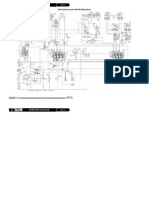UP2 HW CH 20 First Law Thermo Rev
UP2 HW CH 20 First Law Thermo Rev
Uploaded by
rameshaarya99Copyright:
Available Formats
UP2 HW CH 20 First Law Thermo Rev
UP2 HW CH 20 First Law Thermo Rev
Uploaded by
rameshaarya99Original Description:
Original Title
Copyright
Available Formats
Share this document
Did you find this document useful?
Is this content inappropriate?
Copyright:
Available Formats
UP2 HW CH 20 First Law Thermo Rev
UP2 HW CH 20 First Law Thermo Rev
Uploaded by
rameshaarya99Copyright:
Available Formats
PHYS-2326: University Physics-II
Ch-20
Spring-2013
Name: ____________________________________ HOMEWORK PROBLEMS Chapter 20: THE FIRST LAW OF THERMODYNAMICS NOTE: Show the equations and calculations, and box your answer. Be sure to include the units. Solve ALL problems. Any four questions from this HW will be graded, and the marks for this HW will be based on these only. 1. 0.350 kg of water at 20.0C, and 0.300 kg of aluminum at 26.0C are added to a copper container of mass 0.150 kg which is initially at 100C. The container and contents are insulated from the outside, and reach thermal equilibrium after some time. What is the final temperature of the container and its contents?
2. How much heat is required to raise the temperature of 50 gram of ice (a) from -20C to its melting point; (b) convert this to liquid water at 0C; (c) raise the temperature of the resulting water at 0C to water at 100C; (d) convert the water at 100C to steam at 100C; (e) Raise the temperature of steam from 100C to 150C.
3. While reproducing Joules experiment (see Figure 20.1 of the text), you use two blocks of 2.00 kg each. The insulated tank is filled with 250 g of water. When the blocks fall through 3.00 m, what is the increase in the waters temperature?
PHYS-2326: University Physics-II
Ch-20
Spring-2013
4. The temperature of a silver ingot of mass 525 gram increases from 25C to 35C when 1.23 kJ of heat is provided to it. Calculate the specific heat of silver.
5. A vessel contains a large amount of liquid nitrogen at 77.3K (which is also its boiling point). A 1.00-kg cylinder of copper at 40.0C is dropped into the vessel. How many kilograms of nitrogen will boil away by the time the copper reaches 77.3 K? (The specific heat of copper is 0.0920 cal/g C, and the latent heat of vaporization of nitrogen is 48.0 cal/g.)
6. When an automobile is stopped by applying the brakes, the kinetic energy of the car transforms into heat, which raises the temperature of the brakes. If the mass of a car is 1500 kg, and its steel brakes have a mass of 6.00 kg, calculate the temperature of the brakes when the car is stopped from a speed of 30 m/s. Assume all the mechanical energy transforms into internal energy of the brakes, The brakes are originally at 20.0C.
7. (a) Determine the work done on a gas that expands from i to f as indicated in Figure P20.24. (b) How much work is done on the gas if it is compressed from f to i along the same path?
PHYS-2326: University Physics-II
Ch-20
Spring-2013
8. A sample of an ideal gas goes through the process shown in Figure P20.30. From A to B, the process is adiabatic; from B to C, it is isobaric with 100 kJ of energy entering the system by heat; from C to D, the process is isothermal; and from D to A, it is isobaric with 150 kJ of energy leaving the system by heat. Determine the difference in internal energy Eint,B Eint,A.
9. A 2.00-mol sample of helium gas initially at 300 K, and 0.500 atm is compressed isothermally to 2.00 atm. Assume that helium behaves as an ideal gas, find (a) the final volume of the gas, (b) the work done on the gas, and (c) the energy transferred by heat.
10. The surface of a hot steel ingot taken out of the furnace is 800C. If the ingot is spherical with a radius of 10 cm, how much heat is it radiating per second.
PHYS-2326: University Physics-II
Ch-20
Spring-2013
11. At noon, the Sun delivers 1000 W per square meter to a blacktop road. If the hot asphalt transfers energy only by radiation, what is its steady-state temperature?
12. Calculate the amount of heat loss though a glass window made of a single pane of glass 0.100 in. thick, if the temperature inside the room is 70F and outside is 32 F.
13. A bar of steel (iron) has a cross sectional area of 2 cm2. Its two ends are maintained at 0C and 1000C. Calculate the amount of heat that travels through it in one minute.
You might also like
- ManDocument154 pagesManbarun1977No ratings yet
- UP2 HW CH 20 S First Law ThermoDocument5 pagesUP2 HW CH 20 S First Law ThermoVei AdoptanteNo ratings yet
- PHYF144 Tutorial Questions UpdatedDocument16 pagesPHYF144 Tutorial Questions UpdatedAnonymous KUuLddnO98No ratings yet
- Exercises Ch2 2Document3 pagesExercises Ch2 2rawan falatahNo ratings yet
- Homework Set 1Document4 pagesHomework Set 1lishan jayasooriyaNo ratings yet
- Tugas #1 OKDocument2 pagesTugas #1 OKfitriNo ratings yet
- Thermodynamics Exam Summer 2020Document2 pagesThermodynamics Exam Summer 2020John paul Stem11No ratings yet
- ExtraProbPhys2Ch2 HeatTempLaw0Document3 pagesExtraProbPhys2Ch2 HeatTempLaw0NaHuynJungNo ratings yet
- Problem Set (10 Questions) of First-Second Law of ThermodynamicsDocument4 pagesProblem Set (10 Questions) of First-Second Law of Thermodynamicscoolcool2167No ratings yet
- PS21 FinalsReviewerDocument2 pagesPS21 FinalsReviewerIan De La CruzNo ratings yet
- Phy130 Tutorial 8Document3 pagesPhy130 Tutorial 8Shuhaila Hanis RosliNo ratings yet
- Icse X Calorimetry Question BankDocument9 pagesIcse X Calorimetry Question BankanimeshtechnosNo ratings yet
- Thermodynamics IIDocument8 pagesThermodynamics IIFauzan HantoroNo ratings yet
- Tuto PhysicsDocument3 pagesTuto PhysicsLia XeraNo ratings yet
- IB Thermo (2016)Document7 pagesIB Thermo (2016)Hiroki Nose100% (1)
- Tutorial 2 Temperature & Heat - Part 2Document4 pagesTutorial 2 Temperature & Heat - Part 2Yixiang TanNo ratings yet
- TUTORIAL CH 1 - Part 2Document3 pagesTUTORIAL CH 1 - Part 2Adam MrsmNo ratings yet
- Class 4-Specific Heatcapacity - 2009Document3 pagesClass 4-Specific Heatcapacity - 2009bobNo ratings yet
- PHYS 2-Course Materials Fall-2019 Upto MidT.Document5 pagesPHYS 2-Course Materials Fall-2019 Upto MidT.Mohibbullah ShovonNo ratings yet
- Problems 21 Serway 6 eDocument12 pagesProblems 21 Serway 6 eOmari McDuffeyNo ratings yet
- Mock Test For Chemistry For Engineers 2Document2 pagesMock Test For Chemistry For Engineers 2aramikaelatanNo ratings yet
- PHYSCHEM4Document2 pagesPHYSCHEM4Nikki ByrneNo ratings yet
- Rr210304 ThermodynamicsDocument8 pagesRr210304 ThermodynamicsSrinivasa Rao G100% (1)
- PROBLEMSDocument14 pagesPROBLEMSChristian John DumoNo ratings yet
- CH 11Document14 pagesCH 11UbadahNo ratings yet
- Assignment 1, Autumn 2023Document2 pagesAssignment 1, Autumn 2023cocodarshi2022No ratings yet
- EC-I Unit 2 Q Bank 2021-22Document2 pagesEC-I Unit 2 Q Bank 2021-22ZakyNo ratings yet
- Physical Chemistry II - Review of Thermodynamics Chapter 3 The Second Law ExerciseDocument2 pagesPhysical Chemistry II - Review of Thermodynamics Chapter 3 The Second Law ExerciseMary Daphne ButiNo ratings yet
- Charles Boyles Law General Gas EquationDocument5 pagesCharles Boyles Law General Gas EquationSyed Mairaj Ul HaqNo ratings yet
- Me2202 PDFDocument15 pagesMe2202 PDFvis3012No ratings yet
- Keep The Heat AnswersDocument6 pagesKeep The Heat AnswersCiv NortubNo ratings yet
- Chemistry Ii Unit 1 Paper 1Document6 pagesChemistry Ii Unit 1 Paper 1maxime namaNo ratings yet
- Thermometry: T/s T/KDocument9 pagesThermometry: T/s T/KJing Yu VoonNo ratings yet
- Me8391 - EtdDocument3 pagesMe8391 - Etdsyed1188No ratings yet
- Thermal Questions: PDFDocument3 pagesThermal Questions: PDFMonalia SadiaNo ratings yet
- PPNXIIPHYSICSDocument19 pagesPPNXIIPHYSICSAmjad IlyasNo ratings yet
- Problems Sheet Physics (2) - EBA1104Document23 pagesProblems Sheet Physics (2) - EBA1104muhamedhamdy1No ratings yet
- PHY 111, Principles of Physics I: C F 32 K 273.15 M TDocument3 pagesPHY 111, Principles of Physics I: C F 32 K 273.15 M TTanjim IslamNo ratings yet
- CH ETDocument2 pagesCH ETRiddhi ShreeNo ratings yet
- Department of Chemical Engineering Indian Institute of Technology RoorkeeDocument2 pagesDepartment of Chemical Engineering Indian Institute of Technology Roorkeepushkal0% (2)
- Chn-201 Tutorial 2 - Autumn 16-17-1Document2 pagesChn-201 Tutorial 2 - Autumn 16-17-1Prashant RajNo ratings yet
- Examples For Chapter 4Document2 pagesExamples For Chapter 4misganamarcos10No ratings yet
- 73 1st Long Problem Set BDocument13 pages73 1st Long Problem Set BRicardo Jose BracamonteNo ratings yet
- 16TF603 Entropy AssignmentDocument2 pages16TF603 Entropy AssignmentMd Sharique AkhtarNo ratings yet
- Thermodynamics HomeworkDocument3 pagesThermodynamics HomeworkMinhNo ratings yet
- Second Law of Thermodynamics Practice Questions - Without AnsDocument4 pagesSecond Law of Thermodynamics Practice Questions - Without AnsKirti KumarNo ratings yet
- Chapter 4 - ThermodynamicsDocument4 pagesChapter 4 - ThermodynamicsTHIÊN LÊ TRẦN THUẬN0% (1)
- Probset 1bDocument12 pagesProbset 1bRegina Marie MaximoNo ratings yet
- Problems Chapter 1 Sec BDocument7 pagesProblems Chapter 1 Sec BSana AshfaqNo ratings yet
- La Crosse - Thermodynamics Exam 1 - PracticeDocument9 pagesLa Crosse - Thermodynamics Exam 1 - PracticeembededodinNo ratings yet
- Phys 73 1st Ps 1say14-15Document15 pagesPhys 73 1st Ps 1say14-15Marco ConopioNo ratings yet
- Tutorial 5Document1 pageTutorial 5Mimi SaffrinNo ratings yet
- 01 hw1Document2 pages01 hw1Samarjeet Kumar SinghNo ratings yet
- Tutorial 1 - QuestionsDocument5 pagesTutorial 1 - Questions2200851No ratings yet
- 8th Biology Telugu OptDocument202 pages8th Biology Telugu Optrameshaarya99No ratings yet
- Chapter-Iii Subhas Chandra Bose and The Indian National CongressDocument70 pagesChapter-Iii Subhas Chandra Bose and The Indian National CongressPriyanka ChauhanNo ratings yet
- Indian Geography: North Longitudes EastDocument2 pagesIndian Geography: North Longitudes Eastrameshaarya99No ratings yet
- Notification Calling For Nominations For Appointment As Chairman and Members of Telangana State Electricity Regulatory CommissionDocument2 pagesNotification Calling For Nominations For Appointment As Chairman and Members of Telangana State Electricity Regulatory Commissionrameshaarya99No ratings yet
- Year Book 2015Document538 pagesYear Book 2015Omkar Sangle100% (1)
- UPSC: Engineering Services Exam 2014 General Ability Test Key (Held On 20.06.2014)Document1 pageUPSC: Engineering Services Exam 2014 General Ability Test Key (Held On 20.06.2014)rameshaarya99No ratings yet
- Call - No Candidate Name S.No Candidate Name Call - No S.NoDocument141 pagesCall - No Candidate Name S.No Candidate Name Call - No S.Norameshaarya99No ratings yet
- Principles of Production Engineering: Week 1 Structure of MaterialsDocument26 pagesPrinciples of Production Engineering: Week 1 Structure of Materialsrameshaarya99No ratings yet
- A and The Maximum Deflection. EI Is ConstantDocument41 pagesA and The Maximum Deflection. EI Is Constantrameshaarya99No ratings yet
- Chap 5.1 Conditions Equations of Equilibrium of A Rigid BodyDocument52 pagesChap 5.1 Conditions Equations of Equilibrium of A Rigid Bodyrameshaarya99No ratings yet
- Past Exam AnsDocument8 pagesPast Exam Ansrameshaarya99No ratings yet
- 4.36 4.37Document2 pages4.36 4.37rameshaarya99No ratings yet
- 499347059chemistry Question Bank (2013-14)Document94 pages499347059chemistry Question Bank (2013-14)rameshaarya99No ratings yet
- Devaraj Kiruthika 201112 PHDDocument227 pagesDevaraj Kiruthika 201112 PHDrameshaarya99No ratings yet
- KR Multi-V-S R410A 5060Hz HP EU MFL67474080 0CVM0-01AMay.2021Document148 pagesKR Multi-V-S R410A 5060Hz HP EU MFL67474080 0CVM0-01AMay.2021mcpipepiperaNo ratings yet
- Parts Book: Locksti CHDocument13 pagesParts Book: Locksti CHmariaNo ratings yet
- Granulating Machine, Granulators Granulator Machines, Granulators For Pharmaceutical, Pharmaceutical Injection Moulding Machines, Mumbai, IndiaDocument3 pagesGranulating Machine, Granulators Granulator Machines, Granulators For Pharmaceutical, Pharmaceutical Injection Moulding Machines, Mumbai, Indiagreenlite16No ratings yet
- The Tallest Building in Mexico City Torre Mayor Mexico City, MexicoDocument19 pagesThe Tallest Building in Mexico City Torre Mayor Mexico City, MexicojjslfNo ratings yet
- UntitledDocument35 pagesUntitledFaizal JamalNo ratings yet
- Lecture 9 - Plate AnalysisDocument22 pagesLecture 9 - Plate AnalysisAnshul SharmaNo ratings yet
- Truck Lorry ChekclistDocument3 pagesTruck Lorry ChekclistBakri Bin SapilahNo ratings yet
- Doosan VC430-510Document12 pagesDoosan VC430-510LachieDNo ratings yet
- Behavior Factor and DuctilityDocument22 pagesBehavior Factor and DuctilityAndres ArdilaNo ratings yet
- Commissioning Chilled Water TES Tank Systems: Technical FeatureDocument10 pagesCommissioning Chilled Water TES Tank Systems: Technical FeatureJuan Fernando AriasNo ratings yet
- Conventional Power Engineering - Institute Elective - IIDocument2 pagesConventional Power Engineering - Institute Elective - IIKelvin SudaniNo ratings yet
- Replacing Steering Rack 993Document9 pagesReplacing Steering Rack 993Robertus BswhNo ratings yet
- Shell Eco Marathon 2020 Official Rules Chapter One PDFDocument47 pagesShell Eco Marathon 2020 Official Rules Chapter One PDFIkshwakNo ratings yet
- Framecad ConnectorsDocument20 pagesFramecad ConnectorsSannu SyedNo ratings yet
- Manual - Spectr Alert (Outdoor Mounting Installations K Series I56-3222)Document2 pagesManual - Spectr Alert (Outdoor Mounting Installations K Series I56-3222)Célio JúniorNo ratings yet
- iCR 3600 Flat Gear and Motor Replacement: WarningDocument13 pagesiCR 3600 Flat Gear and Motor Replacement: WarningEliana Caceres TorricoNo ratings yet
- Roller Coaster Physics CourseworkDocument4 pagesRoller Coaster Physics Courseworkafaybjktm100% (2)
- ThermodynamicsDocument346 pagesThermodynamicss.ashwin RagavanNo ratings yet
- Tugas GitaDocument4 pagesTugas GitaGita JohannesSaragihNo ratings yet
- Bauchi Geotechnical Soil ReportDocument34 pagesBauchi Geotechnical Soil Reportaezenkwu100% (1)
- Seletora 924F CaterpillarDocument6 pagesSeletora 924F CaterpillarMarco OlivettoNo ratings yet
- Theory of Machines - Josh Ampofo KNUSTDocument60 pagesTheory of Machines - Josh Ampofo KNUSTfanpop botherNo ratings yet
- Numerical Simulation of Shape Rolling: Stanislav RiljakDocument32 pagesNumerical Simulation of Shape Rolling: Stanislav RiljakAli RayyaNo ratings yet
- Tow Master PDF BrohureDocument84 pagesTow Master PDF BrohureClarence SiebertNo ratings yet
- Acceptance Criteria For Weld DefectsDocument2 pagesAcceptance Criteria For Weld DefectsBaljee Singh100% (2)
- Gas Flow ConversionDocument3 pagesGas Flow ConversionFarhan AhmedNo ratings yet
- HCI Torque ChartDocument9 pagesHCI Torque Chartluis sarmientoNo ratings yet
- Patel G. A4Document273 pagesPatel G. A4aminardakaniNo ratings yet
- 7a - Main Hydraulic MAIN MASTER.Document6 pages7a - Main Hydraulic MAIN MASTER.Elmer Romero VilcaNo ratings yet







































































































